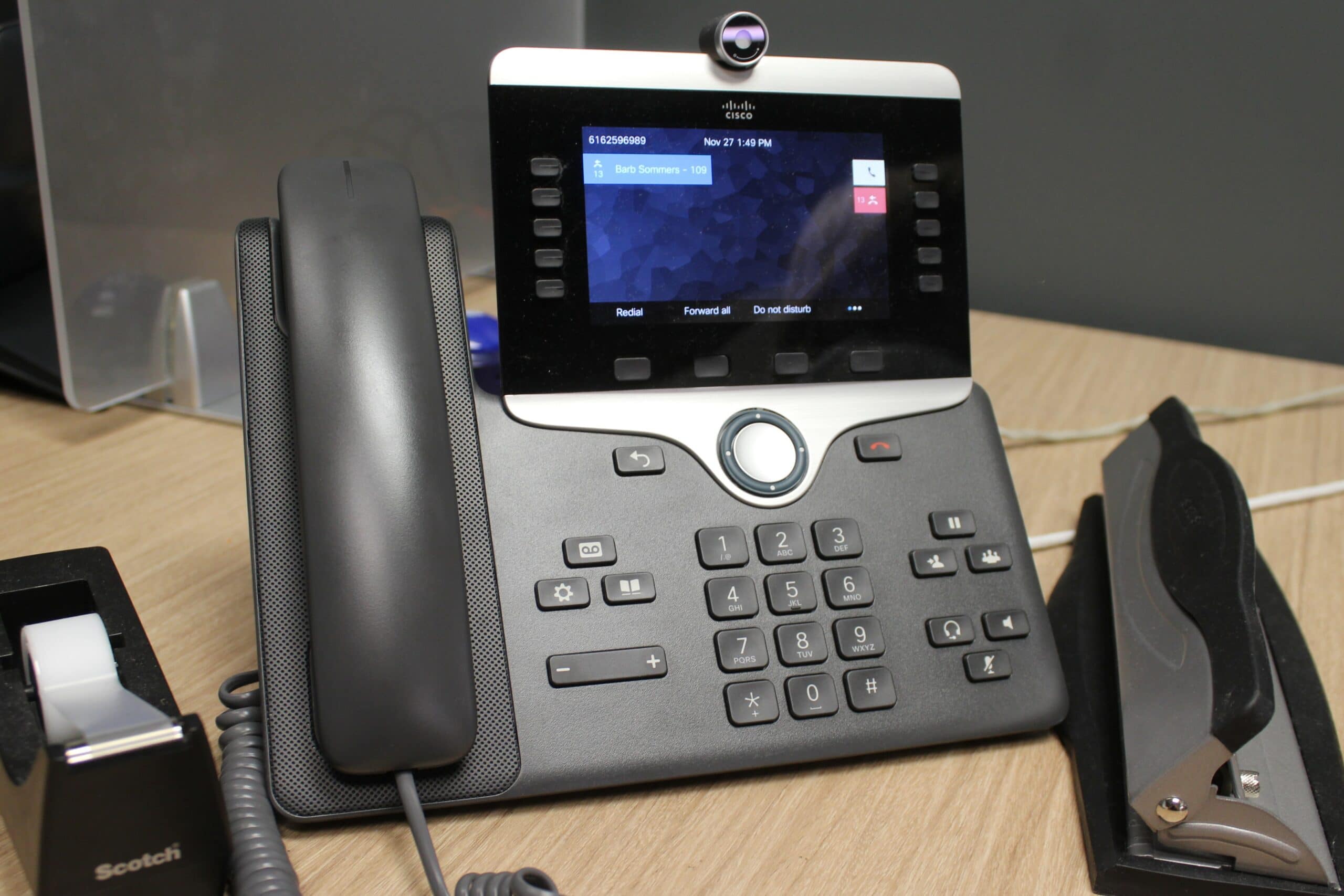
Stay-at-home orders and self-quarantining during the coronavirus pandemic forced all of us to consider what type of communication we find most effective when reaching out to coworkers and customers.
Without the option of formal in-person meetings or even stopping by someone’s desk, we’ve all had to consider how and when to use instant messages, emails, and video meetings.
At The KR Group, we adjusted to this shift internally, and we’ve also helped our customers integrate the technology to use video conferencing with their coworkers and customers.
Video conferences became the next-best-thing when in-person meetings weren’t possible. They also proved how useful they can be as an option more personal than phone calls but not as formal as an in-person meeting.
When in-person meetings are reintegrated into our work lives, we believe we’ll continue to lean on some of the new skills and tools we’ve learned while working from home.
How video calls have changed the way we work
If you weren’t using video before, you were likely addressing customers’ needs through emails, phone calls, and in-person meetings. Which one you chose depended on the type of conversation you needed to have.
Think of video calls as the fourth option among those choices. They can help you when phone calls aren’t enough but you don’t quite need an in-person meeting.
For example, if you’re describing a complex issue that is hard to understand with voice alone, turning the meeting into a video call allows you to share documents, graphics, and even virtual whiteboards.
You can also consider using video if you’re discussing a sale or a more complex issue and want to be able to pick up on nonverbal cues when discussing prices.
This doesn’t mean in-person meetings are obsolete. Just like emails didn’t end the need for phone calls, video conferences won’t put an end to in-person meetings.
The future of in-person meetings
While video calls are a great second-best option, they won’t ever completely replace in-person meetings. There are situations you will always need an in-person meeting.
1. If it’s important to read body language
Video allows you to see the body language of the caller, but it only gives a small window into the other person’s body language.
Depending on how zoomed in the camera is, you might not be able to see if someone is fidgeting uncomfortably or crossing their arms in discomfort.
You can pick up on those cues with an in-person meeting.
2. If your customers request it
When dealing with customers, not all of them will be comfortable with video meetings.
While you can always encourage your customers to participate in video meetings, ultimately, you want to foster the relationship. This may mean holding an in-person meeting instead.
We all know someone who prefers phone calls to emails. Likewise, there will be people who are more comfortable holding an in-person meeting as opposed to a virtual one.
The necessity of video calls has helped familiarize everyone with the technology, but it may still be less comfortable than in-person conversations for some.
3. If you need an edge making a good impression
You only get one shot to make a first impression, and over a video call, it just isn’t the same.
This ties into the previous two points, but the ability to read body language and more naturally make small talk means it is still easier to make a first impression with in-person meetings.
If you’re trying to make a positive first impression or recover from a poor previous impression, having an in-person meeting will always have an edge.
4. If you need to have a hard conversation
You should also opt for an in-person meeting if you need to have a hard or serious conversation.
To avoid miscommunication, an in-person meeting is best for talking through significant issues and working out solutions.
Whether it’s an internal or external issue, in-person meetings are still more productive for these more serious conversations.
Continuing to use video conferencing in the future
In general, if your meeting doesn’t fall under the categories we listed above, it can probably be done over video. This is why video has been so helpful while the majority of employees were working from home.

Now that we’ve all become accustomed to video conferencing and experienced its benefits firsthand, we don’t think the workforce will stop using it once they’re back in the office.
During the first half of 2020, businesses saw countless uses for video meetings and have been able to communicate better than if they were relying on phone calls and emails.
As employees begin transitioning back to in-office work, the value of video conferences over phone calls will continue to be apparent.
A few situations where we think video meetings have helped during quarantine and will continue to be useful after include:
1. If you need to supplement with content
Along with sharing video, most video conferencing platforms allow you to share content.
This can be helpful for conversations where you are talking about a complex topic and need visuals to aid your description.
Instead of relying on the person you’re calling to open an attachment or schedule an in-person meeting, you can use a video meeting to improve your communication.
2. If it’s a quick follow-up meeting
If you need a quick meeting, choosing a video meeting can improve communication and build rapport without having to take time for travel and the formality of an in-person meeting.
Think of video as an option to use in between phone calls and in-person meetings. The video gives you an advantage traditional phone calls are lacking but aren’t quite as intimate as an in-person meeting.
3. If you can’t physically attend a meeting
Even if you have an in-person meeting scheduled, situations arise where you might need to cancel it last minute because you or your customer can’t physically be there.
If it’s appropriate, you can move the meeting to be virtual, and you don’t have to worry about rescheduling for another day.
So what do you need to continue using video in your business operations?
Collaboration tools to continue using video calls
When it comes to video calls, there are a few things we hope you keep in mind when transitioning back to a traditional work environment.
- Video conferencing software
- Video-enabled devices
- An understanding mindset
Many businesses are planning on staggering the reentry of employees to the office or even switching to some level of a permanent remote workforce.
Continuing to rely on these tools can help during this transition as well as in the future.
1. Video conferencing software
To transform your physical meetings to virtual meetings, you’ve had to rely on video conferencing software, such as Webex Meetings.
This technology has allowed you to connect with coworkers and customers while working remotely, and it will continue to be an option even when you’re back in the office.
Video has been trying to edge its way into mainstream business use for many years, but the coronavirus pandemic forced most businesses to finally embrace it.
If you weren’t using video before, you and your employees have had a crash course on how to use it.
Now, video conferencing is here to stay.
2. Video-enabled devices
Since video calls aren’t going anywhere, we’ll continue to need devices capable of making video calls.

Video phones come in many forms. There are video-enabled desk phones, such as the Cisco 8845, touchscreen video phones, such as the Cisco Webex DX80, and external monitor video phones, such as Cisco Webex Desk Pro.
While each of these types of video phones has unique purposes, they all have many benefits over using the integrated webcam on your laptop or smartphone.
- Video phones offer a dedicated device for calling.
- Video phones often have a better quality camera than integrated webcams.
- Video phones allow you to make video calls if your computer isn’t available.
- Video phones allow you to make audio and video calls from the same device.
This technology will continue to be important not only for making one-on-one video calls but also for allowing multiple people within your organization to join conferences that may have traditionally been held in one room.
Even as the workforce returns to the office, social distancing guidelines will remain in effect, including to remain six feet apart when possible.
This means meeting spaces might not be able to hold as many people as they did before the coronavirus — if your company decides to use group meeting spaces at all.
Having video phones allows your employees to join internal and external video conferences even if you aren’t all in one room.
3. An understanding mindset
While not specific to collaboration, we urge you to remember there are a variety of feelings and reactions to the coronavirus and social distancing guidelines.
Just because you feel comfortable resuming in-person meetings doesn’t mean your coworker or customer does. Additionally, feelings and situations may have changed since the last time you gathered around the water cooler.
Most of us want to resume the activities and habits quarantine has changed, but that timeline looks different for all of us.
Collaborating into the future
The coronavirus pandemic has changed many things for businesses, including how we communicate. After months of adapting, it’s unlikely we’ll completely change back to how it was before working from home became ubiquitous.
With the integration of video calls into most business’ communications repertoire, you’ll now be able to consider if you need an email, phone call, in-person meeting, or video call for what you need to discuss.
You’ll also need to continue using a strong video conferencing platform and video-enabled devices.
To learn about Cisco Webex collaboration tools, which include a video conferencing platform, download our free infographic.


